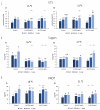Biochemical and Behavioural Alterations Induced by Arsenic and Temperature in Hediste diversicolor of Different Growth Stages
- PMID: 36497501
- PMCID: PMC9738520
- DOI: 10.3390/ijerph192315426
Biochemical and Behavioural Alterations Induced by Arsenic and Temperature in Hediste diversicolor of Different Growth Stages
Abstract
Contamination with Arsenic, a toxic metalloid, is increasing in the marine environment. Additionally, global warming can alter metalloids toxicity. Polychaetes are key species in marine environments. By mobilizing sediments, they play vital roles in nutrient and element (including contaminants) cycles. Most studies with marine invertebrates focus on the effects of metalloids on either adults or larvae. Here, we bring information on the effects of temperature increase and arsenic contamination on the polychaete Hediste diversicolor in different growth stages and water temperatures. Feeding activity and biochemical responses-cholinesterase activity, indicators of cell damage, antioxidant and biotransformation enzymes and metabolic capacity-were evaluated. Temperature rise combined with As imposed alterations on feeding activity and biochemical endpoints at different growth stages. Small organisms have their antioxidant enzymes increased, avoiding lipid damage. However, larger organisms are the most affected class due to the inhibition of superoxide dismutase, which results in protein damage. Oxidative damage was observed on smaller and larger organisms exposed to As and temperature of 21 °C, demonstrating higher sensibility to the combination of temperature rise and As. The observed alterations may have ecological consequences, affecting the cycle of nutrients, sediment oxygenation and the food chain that depends on the bioturbation of this polychaete.
Keywords: behaviour; global warming; invertebrates; metalloids; oxidative stress.
Conflict of interest statement
The authors declare no conflict of interest. The funders had no role in the design of the study; in the collection, analyses, or interpretation of data; in the writing of the manuscript; or in the decision to publish the results.
Figures








References
-
- Andersen J.H., Harvey T., Murray C., Reker J.B., Green N.W. Contaminants in Europe’s Seas: Moving Towards a Clean, Non-Toxic Marine Environment (EEA Report) 2018. European Environment Agency Website. [(accessed on 18 June 2022)]. Available online: https://www.eea.europa.eu/publications/contaminants-in-europes-seas.
-
- Adriano D.C. Trace Elements in Terrestrial Environments. Springer; New York, NY, USA: 2001. Bioavailability of Trace Metals; pp. 61–89. - DOI
MeSH terms
Substances
Grants and funding
LinkOut - more resources
Full Text Sources
Medical
Research Materials

